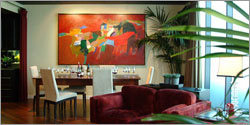Tune in to what top wine bloggers and experts are decanting into cyberspace with handpicked highlights of their latest and greatest.
Proving once again that the selection of fine but affordable wines may be never-ending, Food & Wine serves up the ‘zine’s American Wine Awards ’07. And it comes with menu pairings.
You’ll find seven wines of popular varieties for $20 and under. If you’re feeling a little extravagant, that’s complemented by a list of best wines running over $20. There’s also a winery-of-the-year award going to Washington State’s Long Shadows, which, ahem, is “devoted to producing luxury wines from Washington vineyards in partnership with international winemaking superstars (i.e., people who cast long shadows).”
This year marks the 10th anniversary of the American Wine Awards and features lots of surprises (among them a top Chardonnay from Oregon) and all kinds of labels we bet you haven’t heard of before — plus several you may know very well, including a few repeat award winners.
Think you know the basic ground rules of wine? Maybe not, according to Wine Enthusiast’s fable-busting piece entitled 5 Wine Myths Debunked. Hint: has to do with things like smelling the cork and letting the wine “breathe” a little after uncorking.
To novices, the culture of wine can seem a rarified, untouchable realm best left to sniffing, postulating experts. But delve a little and you’ll find that basic wine appreciation is not only fun, but not all that complicated. The first step? Debunking these popular myths …
A whiff of eucalyptus adds an unexpected aromatic dimension to certain Australian wines, something the vines pick up from the leaves that fall and decay on the vineyard soil. One of the delights highlighted by the 30 Second Wine Advisor in this review of seven down-under winners.
I hadn’t anticipated turning this into an all-Australian week on the 30 Second Wine Advisor ranch, but when the hits just keep coming, it makes sense to go with the flow.
And so it was for me this week, when the tasty Australians that I picked off the shelf for Monday’s and Wednesday’s editions were followed coincidentally by an unexpected visit from an Australian-wine importer who came to town bearing a stellar cluster of beauties from the Antipodes.
At Business Week, Robert Parker focuses attention on what he calls one of white-wine’s best values (the dwindling value of the dollar notwithstanding) — Muscadet from France’s Loire Valley. “Bone-dry” and at their peak, these wines are well within Wine News Review’s fairly frugal affordability index.
The following wines, reviewed by my colleague David Schildknecht, are ‘naked’: unoaked, low in alcohol, and with no residual sugar. They’re from the Muscadet Sèvre et Maine appellation and are sur lie, meaning the wine has been bottled directly from the tank, where the lees (dead yeast cells and remnants of grape skins) remain. That gives the wine freshness and complexity. Muscadets are best during their first three to four years, so these reviews are for the 2005 vintage.
Need more reason to try out a Muscadet? Mary Ewing-Mulligan at Wine Review Online, decrying the “misunderstanding” about Muscadets, recounts her recent encounter with a couple terrific examples over a dinner of raw clams and bouillabaisse at a French bistro.
Muscadet, it seems, has been relegated to a remote fringe of the wine world populated by wines for special needs rather than the more desirable neighborhood of good quality, great-tasting wines. Two things are wrong with this situation: one, it is unfair to the fine Muscadets that exist; and two, it deprives many wine lovers of experiencing the tremendous pleasure they might get from a bottle of Muscadet.

 It’s not just the wine: Napa’s Patz & Hall winery tasting room rocks.
It’s not just the wine: Napa’s Patz & Hall winery tasting room rocks.